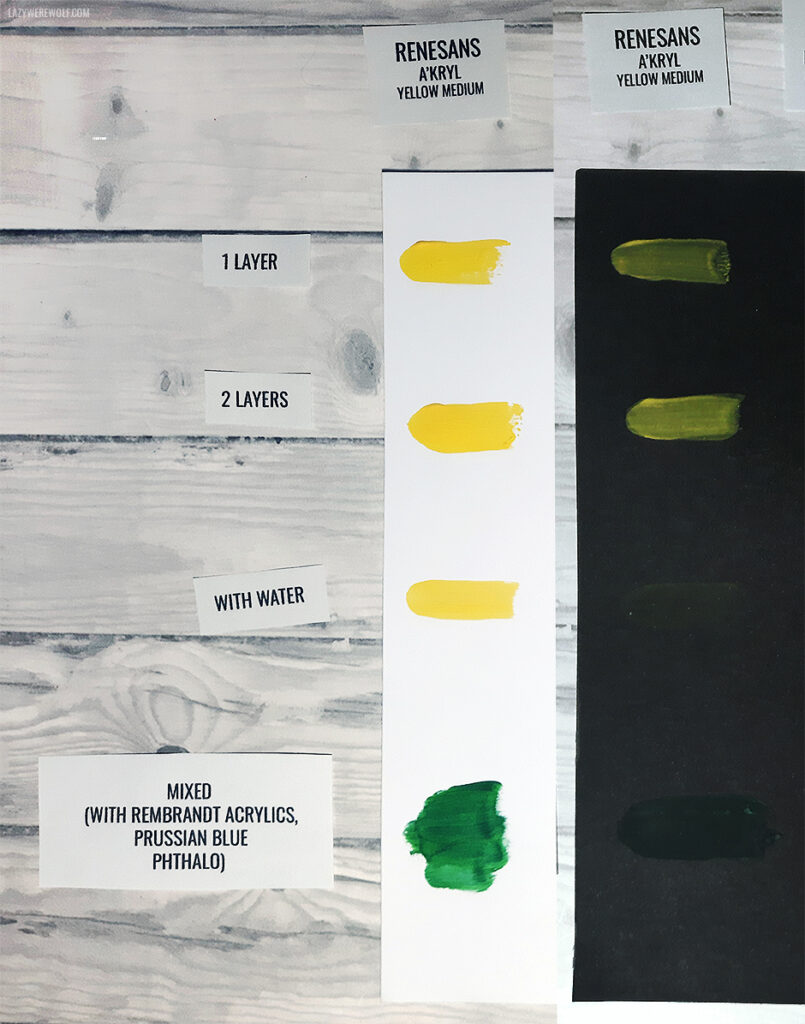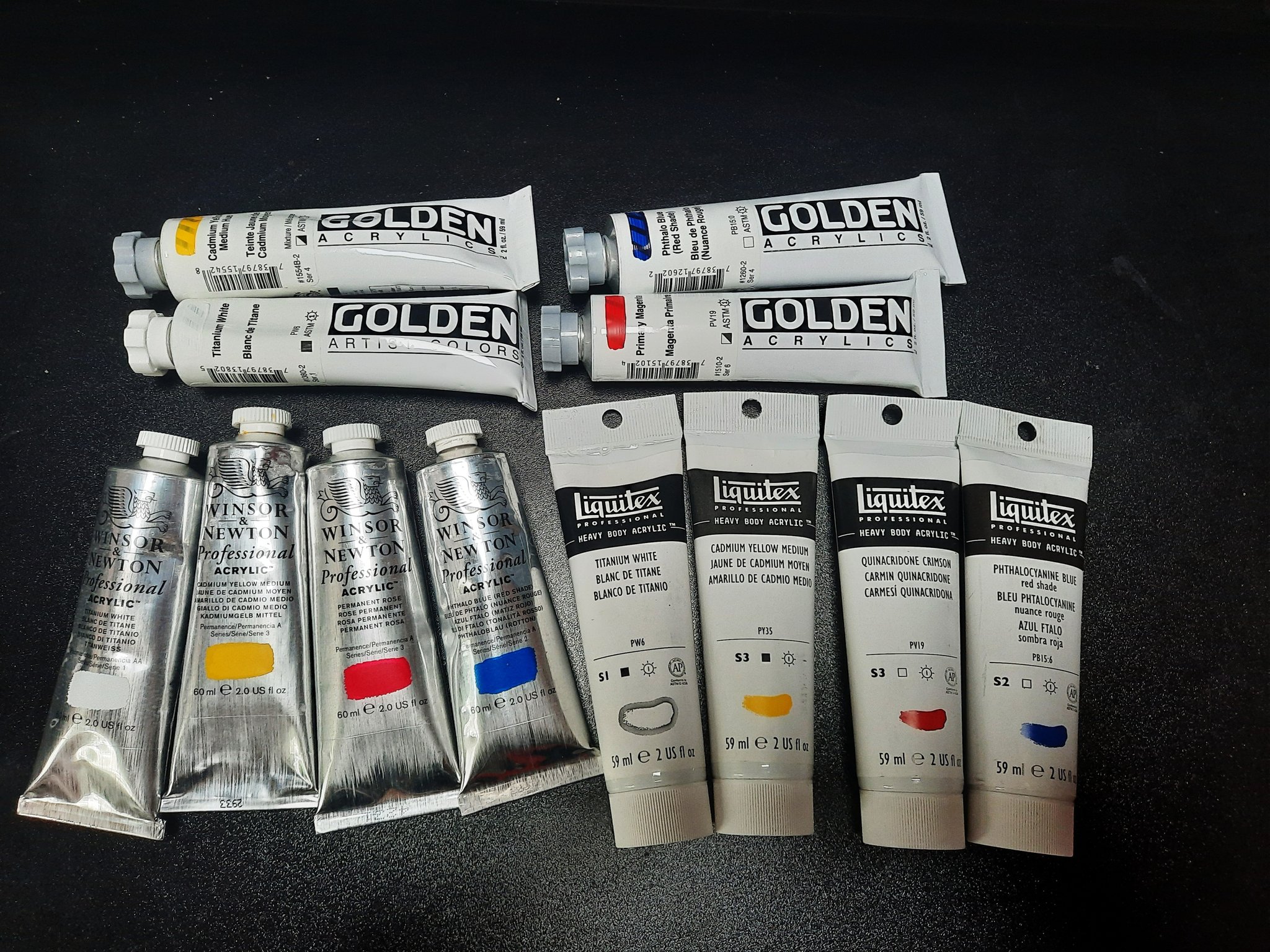Artist-grade Acrylics comparison – Part 1
This entry was brought to you by my Ko-fi supporters.
Hi everyone, long time no see!
You might have noticed I’ve been quiet for a while. I apologize for this – I had some stuff that had to be taken care of but now not only I’m back, but I’m also working on several commissions AND thanks to my Ko-fi supporters I’ve collected enough funds to buy 3 tiny custom sets of artist grade paints to compare them!
But, in this blog post I’ll make a quick comparison of just yellow paints from the 3 brands. Why just yellows? Well, I’ve had a draft for this post prepared several months ago when I did buy a yellow paint from each brand I was going to compare and I chose yellow because, first of all, I could only afford one colour from each set and since I know from experience that yellows are usually ones of the most transparent paints, I decided to compare yellows.
Now, let me give you some more details of the comparison project.
The paints I’ll be comparing are:
- Liquitex Heavy Body Acrylics
- Winsor & Newton Professional Acrylics
- Golden Heavy Body Acrylics

Then, for adding some scale and for a better understanding of higher grade paints’ quality, I’ll also mix in to the comparison the first acrylic paints I used to use and my current paints that I actually really like, and they are, respectively:
- Renesans A’kryl
- Talens Rembrandt Acrylics
I got a Cadmium Yellow Medium colour from each of these paints, except A’kryls which didn’t have any fancy colour name like that, so from this brand, I bought Żółty Średni (Yello Medium). Golden Heavy Body only had a hue version of Cadmium Yellow Medium, so that is the colour I got.
As for my expected outcome of the tests – here is the order of how I think the paints will perform from bad to good (based on what I know myself and what I’ve read about them and seen online):
- Renesans A’kryl (very bad)
- Talens Rembrandt Acrylics
- Liquitex Heavy Body Acrylics
- Winsor & Newton Professional Acrylics
- Golden Heavy Body Acrylics (very good)



The comparison
Prices
All the paints I bought on SzałArt, where they have really low prices, probably the lowest on the Polish market, at least when it comes to reliable stores (not sponsored!).
Renesans A’kryl (Yello Medium)
This was definitely the cheapest paint of them all, costed me only 16,85 PLN for 200 ml tube, which equals to 8,43 PLN for 100 ml (1,91 USD / 100 ml).
Royal Talens Rembrandt (Cadmium Yellow Medium)
For the Rembrandt paint I paid 27,40 PLN for 40 ml tube, which gives 68,5 PLN for 100 ml (15,49 USD / 100 ml). It’s a huge price range leap, but, in this post I’ve already explained some things about the A’kryls’ quality (from my perspective of an artist who is used to painting with Rembrandts). In this case the quality difference translates also to the price difference.
Liquitex Heavy Body Acrylic (Cadmium Yellow Medium)
The Liquitex Heavy Body tube was more expensive – I paid 50,15 PLN for 59 ml tube (a bit bigger than the Rembrandt tube), which equals to 85 PLN for 100 ml (19,24 USD / 100 ml).
Winsor&Newton Professional Acrylic (Cadmium Yellow Medium)
I stayed in the same price range here – 55,75 PLN for 60 ml tube, so 92,92 PLN for 100 ml (21,05 USD / 100 ml)
Golden Heavy Body Acrylic (Cadmium Yellow Medium Hue)
Golden’s price was very close to Winsor&Newton – I paid 54,70 PLN for 59 ml tube which equals to 92,71 PLN for 100 ml (21,01 USD / 100 ml).
Features
During my tests I was observing several features of the paints, that were important for me, like the paints’ opacity, mixing ease, shine and the tubes’ quality.
The opacity and mixing were the easiest to test and present the results. For this purpose I prepared 2 sheets of paper – white and black, so it’s easy to tell how the paints would behave both on light and dark surfaces.


As you can see all the paints look fairly similar on the white paper and the differences are starting show much better on the black paper.
First, as I said earlier, A’kryls were put in this comparison for the scale of difference between starter acrylic paints and artist-grade paints. And I’d like to show you a close-up of A’kryl’s opacity tests.

You can easily tell that on the white surface the paint doesn’t look that bad, but the black paper makes it almost invisible! I’ve revisited these paints a while ago, so I can say that this is also how they feel when you’re painting with them on areas already covered with some colours to fix or adjust them – you keep adding layers and layers of paints but they’re barely visible AND they dry into different colours than they are when they’re wet. You can read more about the struggle here.
The difference between the A’kryls and Rembrandts is huge. But the difference between the Rembrandts and the rest of the paints isn’t that profound. Furthermore, the 3 professional paints that I’m comparing don’t differ in their opacity and mixing performance that much. But, since there was more features to compare, and I wanted an easy way to tell which paints performed the best, I decided to put those features in a table and grade the paints in comparison to the others and see which ones either are the best or I like the most.
Note, that the numbers in the table are not scale grades, they are comparison grades – the worst paint gets a 1 and the best one – a 5. For each feature, I marked the 2 best performing paints in green and the worst ones in red. The rest that was neither the best nor the worst – I marked in yellow. In Smell strength the grades are reversed because the less smell, the better 🙂
wpDataTable with provided ID not found!A quick glance at the table can tell you that, overall, Liquitex Heavy Body paints performed the best or at least very good in most categories and I’m very surprised by this turn of events. For some reason, even though I’ve heard a lot of good things about them, I associated Liquitex with mediocre paints. I did expect Liquitex Heavy Body paints to perform better than my Rembrandts, but not the best from all the 3 professional grade paints! But must admit that the Liquitex paint surprised me with its opaqueness and almost lack of any smell. I look forward to working with them more often.
I’m not sure why, but I wanted to love the Winsor & Newton paints, but sadly, aside from the intense smell, there was nothing special about them. I heard from many sources that Winsor & Newton Professional are one of the best acrylic paints out there, but in my tests, this yellow one at least performed the worst out of my artist-grade paints. I would like to give these paints a chance to redeem themselves because I can’t simply believe such a high praised product can turn out to be… “meh”.
I’ve heard so many praises of Golden paints too, that I almost expected them to paint on their own after being squeezed out of the tube… and of course that didn’t happen. But the Golden yellow paint that I’ve tried did have an incredibly interesting buttery texture I haven’t seen in acrylics before. The paint was also slightly more liquidy than the other paints and I suppose that was the reason it was a little less opaque, too. Even though Golden wasn’t the winner of this comparison, its texture made me super curious about the paint and I want to experiment a bit more with this brand to learn if it’s really as good as I heard.
The summary
I loved this experiment and if my budget affords it – I’d like to do this kind of thing a more often. But as for the paints – even though the swatching test was important, interesting and told me a lot about the paints, the experience of actually working with them on a more ambitious thing, which is a painting, might be different and change my opinions about them completely! Even though the Liquitex was the best in most categories of the simple test I performed, it may be difficult to work with it while mixing. Or, because of its thickness and opacity, it may leave thick brush marks on the canvas, which I don’t like. And Winsor & Newton paints, even though they smell horrible, they might be a dream to work with! Who knows?
Not me… Yet. Thanks to my amazing supporters on Ko-fi I was able to buy several tubes of paint from each brand and I’ll test them soon, and, after I’m done, I’ll return to you with the results in part 2 of this blog post.

Besides the yellows, I’ve already had white Liquitex paint, so I only needed reds, blues and whites for where they were missing, to finish the sets. And of course, the sets consist of primary colours, according to colour theory and my resources still were somewhat limited, so I couldn’t buy bigger sets. still, I can’t wait to start mixing these paints and testing their features and performance!
Have you tried any of these paints? If yes do you have your favourite? Or maybe you prefer a completely different brand? Let me know, I’d love to hear about it!
~Kat

